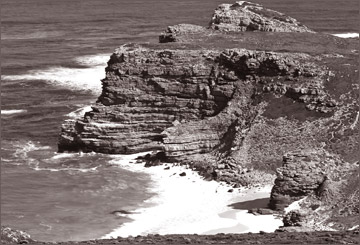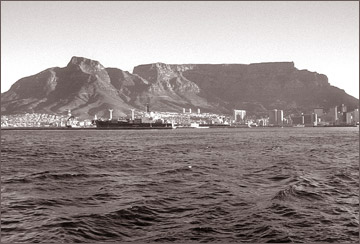Rainbow Nation South Africa
Premasara EPASINGHE
This December, 2011, Sri Lanka national cricket team begins an
adventurous, tough, challenging cricket tour in South Africa. Way back
in 1998, I had the good fortune of touring South Africa, one of the most
beautiful countries that I have seen. Johannesburg, Paal, Kimberley,
Pretoria, Cape of Good Hope, Robben Island and Bloemfontain are some of
the places I visited. The sight from the top of Table Mountain, Cape
Town was the most beautiful sight I witnessed in mylife and it is still
etched in my mind.
 |
|
Cape of
Good Hope |
On the eve of SL-South Africa Cricket tour, for the benefit of our
readers, I pen these few lines about the geographical and historical
background, apartheid SA before 1995 and a summary of social and
political history and specially on the Father of the Nation the Chief
Architect of One Country One Nation The Greatest Man of the 21st
Century Nelson Mandela.
South Africa, is the southernmost country in Africa. A narrow coastal
margin includes, the India Ocean, Port of Durban; the dry South
tablelands, Little and Great Karoo, Cape Town on the Cape of Good Hope
and part of Namib Desert.
The interior forms part of the African Plateau. It rises in the East
to an escarpment more than 2,000 m (6,000 ft) high, on the fringe
Bloemfontein, the judicial capital of SA, capital of Free State. Dutch
farmers settled here in the early 19th century. It contains the oldest
Dutch Reformed Church in South Africa. Then, there is SOWETHO South
West Township on the outskirt of Johannesburg a city in North East
Republic of SA, capital of Gauteng Province, founded in 1886.
Today, it is the leading industrial and commercial city and the
administrative headquarters for gold mining companies, industries etc.
The capital of South Africa is Pretoria in the Gauteng Province, which
was founded in 1855. It was named after Andries Pretorius (1799 1853)
Afrikaner Leader in the Green Trek (1835) to Natal.
He defeated Zulus in 1838. Pretorius was instrumental in establishing
the Independence of Transvaal, as the South African Republic (1852). His
son, Marthinus Wessels Pretorius (1819-1901) served as the first
President of the New Republic (1857-71) and Orange Free State
(1859-1863).
The highest peaks in the Drakensberg Range, on the border of Lesotho
(Formerly Basutalend) an enclave kingdom within the Republic of South
Africa and its capital is Maseru.
In the North lies, the Kalahari Desert. It covers parts of Botswana,
Namibia and South Africa, between the Orange and Zambezi rivers.
In the North East are Witwattersand gold fields series of parallel
mountain ranges more than 5,000 feet high, forming a watershed between
Vaal and Olifant rivers in Transvaal N.E. South Africa. Kimberley has
the largest Diamond mines in the world. It is the capital of Northern
Cape Provinces founded in 1871.
The Kruger National Park lies on the border with Mozambique. This
famous game reserve is in the Northern Province. It was founded on 1898,
by Paul Kruger, as the Sabi Game Reserve. It became a National Park in
1926. It covers an area of 20,700 sq km/8000 sq ml, approximately. The
longest river in SA is the Orange. It rises in the Drakensburg Mountains
in North Lesotho and flows serenely West forming the boundary between
free state and Cape Province. It empties into the Atlantic Ocean at
Orangemund. The length of the Orange River is about 1,300 miles or 2,100
km.
Climate Vegetation
The climate of SA is sub topical. In the South West you find the
Mediterarian climate. Plateau is arid. Namib Desert is rainless.
Forest and woodland cover about three percent of the land. Grassland
covers the highlands. Scrub vegetation is found in the Cape Region.
History
South Africa possesses a proud history. Its indigenous people were
known as San. In 1652, Dutch East India company founded a colony at
Table Bay. Dutch Afrikanars known as Boers established farms. They
employed slaves. From late 18th century conflict arose with Xhosa
Tribes. By early 19th century Britain gained control, and they abolished
slavery in 1833.
The Boers began the great trek. In 1852 and 1854, Transvaal and
Orange Free State were established respectively. The Britishers were
interested in Diamonds and Gold and they fought against Zulus at the
Whiles, annexed Zululal in 1897. In 1890, Cecil Rhodes, became the
Governor of Cape Colony. Britain defected Boers in SA wars (1880-81) and
(1899-1902).
 |
|
Table
Mountain. Picture courtesy: Google |
A new era began in 1910, when Union of South Africa was formed with
Louis Botha as Prime Minister. Botha (1862-1919) was a politician, and a
military leader. During the South African war (1899-1902), he was an
outstanding commander.
He led the delegation at the Transvaal Peace conference. In 1912, the
African National Congress (ANC) was founded.
In 1919, Jan Smuts succeeded Botha. Jan Christian Smuts (1870-1950)
was the Prime Minister from 1919-1924 and 1939-1948. He was a guerrilla
commander during South Africa War (1899-1902) at later worked with Botha
to establish the Union of SA in 1910. After the 2nd World War, Smuts was
defected by the Apartheid Policies of the National Party.
Apartheid
The Nationalist Party, came to power in 1948 Elections, advocately a
policy of Apartheid. It is a policy of Racial Segregation practised by
South African government from 1948-1990, for 42 years. Racial inequality
and restricted rights for the Non-Whites were institutionalized when the
Afrikanar dominated National Party came to power in 1948, officially, a
framework for Separate Development of races in practice, Aparthied
enforced white minority rule. It was based on segregation in all aspects
of lie including Residence Land Ownership, and Education. Non-whites
eight percent of the population, were also given separate political
structures, and Quasi-Autonomous homelands and Bhantustans.
The system was underpinned by extensive repression, the measures such
as pass laws which severely restricted the movements of non-whites. In
1990, S. African government, increasingly isolated internationally and
beset of economic difficulties and domestic unrest, pledged to dismantle
the system. The elections in April 1994 completed the transition to a
non-racial democracy.
The African National Congress ANC Political party formed in 1912,
aimed of securing racial equality and full political rights for
non-whites. By 1950, ANC was the main oposition to Apartheid. A military
wing Umkhonte We Sizwe (Spear of the Nation) was set up after the
Sharpeville massacre. In black township of Sharpeville, local people
Blacks, demonstrated against the press laws. The Police opened fire on
March 1960, to disperse these innocent men, killing 67 and wounding 186.
The massacre led to greater militancy in the struggle against Apartheid.
The ANC began a campaign and great leader, national patriot Nelson
Mandela formed a military wing Umkhonte-We-Sizwe (Spear of the Nation).
In 1961, faced by International condemnation Prime Minister Hendrik
Verwoerd establish South Africa as a Republic. Born in Holland, Hendrik
Frensch Verwoerd (1901-1966), was a vocal advocate of Apartheid.
He promoted separate development, which means physical separation of
races. He led South Africa out of Commonwealth of Nations in 1961. He
was assassinated by a white extremist. Verwoerd was succeeded by
Johannes Vorster.
Soweto Uprising - 1976
The South African Prime Minister Balthazar Johannes Vorster
(1915-1983), who was imprisoned during the second world war as a Nazi
Sympathizer.
He was a staunch advocate of Apartheid. Vorster, established Trankei
as a Buntaitan and suppressed the Soweto uprising.
Soweto, South West in South Africa, was a Black Township of more than
a million. This town is on the outskirt of Johannesburg. In 1976, Soweto
attracted international attention, when a student demonstration against
the compulsory teaching of Afrikaners in Bhantu schools sparked a series
of Riots against Apartheir Regime. The Police brutally suppressed the
disturbance, killing 618 people.
In 1978, P. W. Botha was elected Prime Minister. Pieter Willen Botha,
was the longest serving member of Apartheid. He became the first
President of South Africa in 1980 and was re-elected in 1987. In 1989,
he suffered a stroke and amid National Party factionalism, he resigned
and was replaced by more reform minded F. W. De Klerk.
In the year 1989, Frederik Willem de Klerk was the President of South
Africa from 1989-1994. In 1989, de Klerk led a Palace Coup against P.
W. Botha and became the President and National Party leader.
Following the narrow election victory, Klerk began the process of
dismantling Apartheid. Further in 1990, the ban on the African National
Congress ANC was lifted and Nelson Mandela was released. He served 27
years in prison, many years in Robber Island.
Father of the South African Nation - Nelson Mandela
Nelson Mandela was born on July 18, 1918 at Mvezo, a tiny village can
be considered as the Father of the South African Nation. He served as
the President from (1994-1999). He ushered the Golden Era of South
Africa.
This great patriot joined the African National Congress in 1944 and
for the next 20 years led the campaign of civil disobedience against
South Africas Aparthaid governments. Following the Sharpeville massacre
(1960), Mandela formed Umkhonte We Sizwe (Spear of the Nation) a para
military wing of ANC. In 1962, Mandela was acquitted on charges of
Treason, but in 1964, Mandela was sentenced to Life imprisonment for
political offences.
He spent 27 years in Prison, on Robber Island. It became the symbol
of resistance to Apartheid. In February 1993, Mandela was released and
he resumed his leadership of the newly legalized ANC. In 1993 Mandela
and Klerk shared the Nobel Prize.
In 1994, Mandela gained two-thirds of the popular vote in South
Africa's first multinational elections. A fine advocate for the need of
reconciliation, he made de Klerk Deputy President (1994-1996) in his
government for National Unity.
Rainbow nation
Nelson Mandela struggled for a Democratic South Africa for much of
his life. This great leader and patriot spent 27 years in prison,
charged with attempting to overthrow the government of the whites. He
was largely responsible for the Peaceful Revolution, that transformed
South Africa into a Multiracial Rainbow Nation.
Mandela's great Diplomacy, etiquette, mannerism, charismatic,
personality, compassion and benevolence made him a figure of great moral
stature. On May 16, 1994, at Union Bank Building, Pretoria, Presidential
inauguration of Nelson Mandela took place, with number of world leaders
in attendance.
In 1999, Thambo Mbeki, replaced Nelson Mandela as the President of
the ANC in 1997, became president of South Africa. To be a Freedom
Fighter, one must suppress your world personal feelings and must be
committed for the cause. Mandela did that.
This great leader, Nelson Mandela, addressed both head and heart, but
it was the heart that won the day. Dignity was the hallmark of all his
actions. I consider Nelson Mandela, the greatest man of the 21st
century.
[email protected] |



